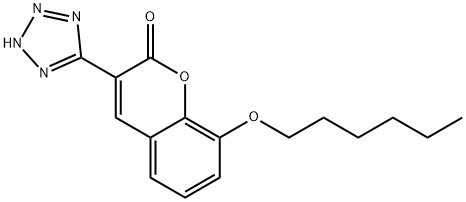KP136
| 中文名称 | KP136 |
|---|---|
| 中文同义词 | 化合物 T15666;化合物 KP136 |
| 英文名称 | KP 136 |
| 英文同义词 | AL-136;KP 136;8-(Hexyloxy)-3-(1H-tetrazol-5-yl)-2H-1-benzopyran-2-one;8-(Hexyloxy)-3-(1H-tetrazol-5-yl)coumarin;2H-1-Benzopyran-2-one, 8-(hexyloxy)-3-(2H-tetrazol-5-yl)-;KP-136,KP136;8-Hexyloxy-3-(1H-tetrazol-5-yl)-2H-chromen-2-one |
| CAS号 | 76239-32-2 |
| 分子式 | C16H18N4O3 |
| 分子量 | 314.343 |
| EINECS号 | |
| 相关类别 | |
| Mol文件 | 76239-32-2.mol |
| 结构式 |  |
KP136 性质
| 储存条件 | Store at -20°C |
|---|---|
| 溶解度 | 溶于二甲基亚砜 |
Histamine release
KP136 (0.01 μg/mL) inhibits this histamine release and degranulation in a dose-dependent manner, confirming that it is an inhibitor of mast cell activation. The IC 50 is 76.1 μg/mL for histamine release and 63 ug/mL for degranulation.
C4C at 0.2 mg/kg produces an equipotent effect to 1 mg/kg KP136 (KP-136) or 5 mg/kg DSCG. However, C4C is less effective by the oral route because it only produces a maximum inhibition of about 35% even at the high dose of 100 mg/kg, whereas KP136 shows an overt inhibitory effect of about 66% at the oral dose of 2 mg/kg. On the other hand, KP136 (1 mg/kg, i.v.) also remarkably inhibits 5-h homologous PCA, having an activity similar to that of C4C.
